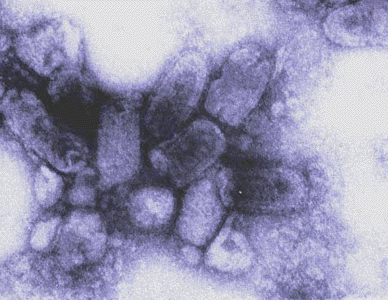Rabies Virus

photo coutesy of: http://www.wadsworth.org/rabies/virus2.htm
Incubation Period:
The incubation period for the Rabies Virus is long and highly variable. It is determined by the concentration of the virus, the proximity of the wound to the brain, the severity of the wound, the host's age, and the host's immune status.
Transmsission:
Infection results from the bite of a rabid animal. There is a secretion of the virus in the saliva. It is also transmitted through the inhalation of the aerosolized virus, in transplanted infected tissue, and by incoluation through intact mucosal membranes.
Epidemiology:
Rabies is a classic zoonotic infection, and it is endemic in many animals worldwide, except in Australia. The virus has no seasonal incidence. Dogs are the primary transmitter of the virus in urban areas. The virus can also be spread by infected bats, skunks, raccoons, bats, and farm animals. In the United States, the virus is more prevalent in cats since they tend to not be vaccinated. Rabies is a problem in Latin America and Asia because of the high number of stray dogs and the absence of effective vaccination programs. In South America, it is common for vampire bats to transmit the virus to the cattle. In Western Europe, badgers and foxes tend to spread the virus.
Symptomatology and Outcome:
During the prodrome phase, symptoms include fever, nausea, vomiting, anorexia, headache, lethargy, and pain at the site of the wound. These symptoms may last anywhere from 2 to 10 days. The next phase is known as the neurologic phase, which lasts for 2 to 7 days. Symptoms includes hydrophobia, phayrngeal spasms, hyperactivity, anxiety, and depression. CNS symptoms may include loss of coordination, paralysis, confusion, and delirium. The following phase is coma, which lasts up to 14 days. Symptoms include cardiac arrest, hypotension, hypoventilation, and secondary infections. After coma, death is imminent.
Prevention and Management:
Rabies is almost always fatal. Therefore, once symptoms have appeared, an infected individual can only rely on supportive care. However, if exposed individuals follow the following steps and recieve post-exposure prophylaxis, symptoms do not appear. The first step is to wash the wound with soap and water (or any other substance that inactivates the virus). Then one dose of Human Rabies Immune Globulin should be administered to the infected individual with the vaccine. The vaccine is a killed-virus vaccine prepared through the inactivation of rabies-infected tissue culture human diploit cells or fetal rhesus lung cells.A series of 5 immunizations are given over a course of a month. It is administered intramuscularly on the day of exposure and then on days 3, 7, 14, and 28. Animals, laboratory workers, and travelers should receive pre-exposure prophlaxis. This is given intramusuclarly or intraderamlly in 3 doses, and it provides 2 years of protection. Many vaccination programs have been implemented to control rabies.
References:
Murray, Patrick, Ken Rosenthal, George Kobayasm, and Michael Pfaller. "Medical Microbiology." 4th Edition. Mosby, Inc. 2002. pp. 551-555.